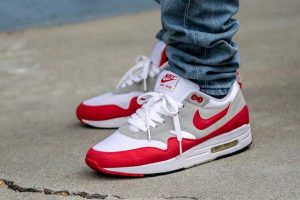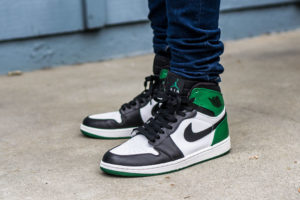Sneaker longevity is a question that continues to puzzle collectors. Many are concerned specifically with whether Nike shoes last long, considering the high cost of some of them.
Lifespan of a Nike Sneaker
If worn casually every day, most Nikes will last between 1-3 years. Hard activity like running or other sports will lower the lifespan to around a year. In storage, the materials used will determine how quickly the sneakers age.
How quickly the sneakers deteriorate and in what way they do so depends on the frequency and activity level when worn. For Nikes worn daily, the midsole will gradually wear away and the tread will slowly disappear. When the midsole is too fargone, traction and wearability will start to suffer. Additionally, a sneaker worn too long eventually will wear the midsole right through!
Sports activity can wear Nikes down more quickly. Instead of a year or three, sneakers used in sports can wear out in as little as a few games or runs. The harder you are on your shoes, the faster the uppers will rip or otherwise deteriorate. As with daily wear type sneakers mentioned above, more rugged materials can lengthen a shoe’s life. I’ve worn through a pair of Kobes in a few weeks playing basketball outdoors once or twice a week.
For collectors, daily wear and damage might not be a problem, but the elements can affect how the sneaker fairs in storage. Collectors tend to have enough sneakers to rotate in a different pair every few days, which means the other shoes sit. Too moist or too dry of an environment combined with the materials used on the sneaker will have an effect on longevity.
I’ve found that some of my pairs have lasted the entire time I’ve been collecting – over 15 years!
Nike Shoes Fall Apart Over Time
Any sneaker worn often enough will accumulate enough damage to eventually come apart. Conversely, sneakers that are stored at length suffer from glues drying out and/or midsoles disintegrating.
Shoes are made to be worn, and Nikes are no different. With daily wear or sports activity, sneakers eventually accumulate enough damage and wear-through that they can start coming apart at the seams! Take a look at photos of any skate, basketball or running shoe after their intended sports use and you may see holes, rips, tears and loose midsoles. Even shoes that are simply walked in can eventually incur such damage.
Collectors face different issues with sneaker longevity! Some Nike shoes last long in storage while others succumb to the elements more readily. EVA (Ethylene Vinyl Acetate) midsoles crumble on older sneakers, especially if stored as opposed to occasional wearing. This happens often with certain Air Jordan models (more on this below).
Glues and paints on older Nikes can dry up over time. Wearing the shoe occasionally and storing it properly helps avoid this for longer, but the drying out will still eventually occur. Shoes that sit for long periods of time often suffer from paint peeling (especially painted leather) and separated outsoles and midsoles due to dried up glues.
Storing Nikes in too humid of an environment can cause them suffer from mildew and mold, while overly dry environments can result in the aforementioned drying out and peeling. Taking the sneakers out of the box and wearing them, then allowing the sweat to evaporate from the sneaker before storing them again are ways to combat this issue. Modern releases tend to use more advanced glues and materials that help against some of the issues mentioned, but the science is not yet consistent at this time.
Nike Air Max Lifespan
Air Max are not among the Nike shoes that last long; typically less than 10 years. The Air units in these sneakers can break down and even pop with age and/or use! The first signs of this are usually midsole cracks and/or a foggy Air unit.

Read about Air Max 1s
Buy These: eBay
Nike Air units will not last forever. Older pairs with EVA midsoles suffer from this even more, as cracks in aging midsoles expose the Air bubbles to more issues.
There’s a reason Nike regularly re-releases various Air Max besides capitalizing on nostalgia for some easy money. The shoes will also become unwearable if they sit in the box for too long!
Some believe that sealing off the sneaker from the elements (i.e. shrink wrapping or otherwise air-proofing the shoe) will help, but this will actually damage an Air Max faster. A sealed-up shoe doesn’t have the required moisture from the environment to not completely dry out and crumble. The internet is littered with photos of Air Maxes fresh out of deep storage completely crumbling underfoot.
Retro Air Jordan Lifespan
Similar to Air Max sneakers, Air Jordans can last around 7-10 years in storage. Occasionally wearing them can increase this time period. Conversely, wearing them daily can accelerate their deterioration.

Still Going Strong!
Buy These: eBay
Particular older Air Jordan models such as the Air Jordan 3, 4, 5 and 6 can often suffer from midsoles crumbling and Air bubbles fogging and popping or cracking just like the Air Maxes described above. The same types of rules apply; wear the sneakers every now and then to keep the midsole pliable, but not so much that the outsoles wear through. Sealing the sneaker off from the elements in the long run does more harm than good with respect to this.
Other models like the Air Jordan 11 run into different issues. Typically, the outsole and midsole will separate over time, as they are all held together by glues. Wearing the shoes occasionally can help with this, but the issue will still eventually happen.
An exception to all of these issues are Air Jordan 1s, which have an encapsulated Air unit and seem to last forever! While very old, dried-out pairs can crumble with the best of them, many pairs operate more like tanks, seemingly getting stronger the more they are worn.
Current Air Jordans in production may use slightly different midsole materials and have a bit better tech overall, even in retro releases. This helps stave off some of the drying out and crumbling for longer. Still, even modern releases are susceptible to aging out over time.
Nike Dunk Lifespan
Nike Dunks seem to last forever, thanks to the materials used in the midsole and lack of an Air unit. When properly stored and cared for, even original pairs from 1985 are still wearable!

Read about Nike Dunks
Buy These: eBay
I get asked about Dunk longevity a lot. Do these Nike shoes last long? They do! While other models seem to crumble around them, Dunks hold on strong!
Of course, storing them in an overly dry environment with no air flow can lead to a crumbled midsole, but the odds of this are much lower than in an Air Max or Air Jordan. Similar to the Air Jordan 1, these are tanks!
Even if the glues dry up on a Dunk midsole, stitching will still keep the midsole and sole attached to the shoe. Thus, even with issues from age, the sneakers seem to hold up. If worn occasionally, the glues stay flexible enough to postpone drying out.
Earlier Dunks often used painted leather, and on a few of my pairs the paint has started to peel and chip. One or two pairs also used vinyl liners which crack and tear in storage. Despite these issues, these kicks are still wearable more than 20 years after their release.
How To Make Nikes Last Longer
Wearing Nikes carefully can help prevent damage to the uppers. Daily wear will run through a sneaker quickly. However, limiting wear to occasional non-sports usage keeps them from getting beat up while preventing drying out of glues and midsole materials.
Sneakers are meant to be worn and not built to last forever. Of course, your daily pair will suffer the effects of being worn, reducing its lifespan overall. Buying additional sneakers and developing a rotation of sneakers is one solution to the problem.
However, storing the sneakers won’t allow your Nike shoes to last long either. The best solution for Nikes, especially those with limited midsole and/or Air bubble life is to wear them occasionally to keep the shoes flexible.
Your choice of Nike will affect its longevity. Dunks, Air Jordan 1s, Blazers in addition to other recently produced casual sneakers lacking an Air unit could last over a decade as long as they are occasionally worn. Remember, all sneakers eventually deteriorate from use or storage or a combination of the two.
